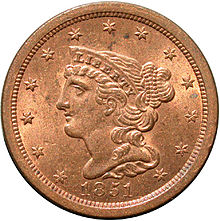Half cent (United States coin)
United States | |
| Value | 5 milles (0.5 cents or 0.005 US dollars) |
|---|---|
| Diameter | 23.5 mm |
| Thickness | 2 mm |
| Edge |
|
| Composition | 100% copper |
| Years of minting | 1793–1857 |
| Obverse | |
 | |
| Design | Liberty with braided hair |
| Designer | Christian Gobrecht |
| Design date | 1840 |
| Reverse | |
 | |
| Design | Denomination surrounded by a wreath |
| Design date | 1840 |
| Design discontinued | 1857 |
The half cent was the smallest denomination of United States coin ever minted. It was first minted in 1793 and last minted in 1857. It was minted with five different designs.
History[]
First authorized by the Coinage Act of 1792 on April 2, 1792,[1] the coin was produced in the United States from 1793 to 1857. The half-cent piece was made of 100% copper and was valued at five milles, or one two-hundredth of a dollar. It was slightly smaller than a modern U.S. quarter with diameters 22 mm (1793), 23.5 mm (1794–1836) and 23 mm (1840–1857).[2] Coinage was discontinued by the Coinage Act of February 21, 1857. They were all produced at the Philadelphia Mint.
Design varieties[]





There are several different types of half cents:
- Liberty Cap, Facing left (designed/engraved by Henry Voigt) – issued 1793
- Liberty Cap, Facing right (large head designed by Robert Scot, small head designed by Scot-John Gardner, engraved by Robert Scot) – issued 1794 to 1797
- Draped Bust (obverse designed by Gilbert Stuart and Robert Scot, reverse designed by Scot-John Gardner, engraved by Robert Scot) – issued 1800 to 1808
- Classic Head (designed/engraved by Robert Scot or John Reich) – issued 1809 to 1836
- Braided Hair (designed by Christian Gobrecht) – issued 1840 to 1857
There are no mint marks on any of the coins (all minted at the Philadelphia Mint) and the edges are plain on most half cents. On the 1793, 1794 and some 1795 coins and a variety of the 1797 coin, it was lettered TWO HUNDRED FOR A DOLLAR and another 1797 variety had a gripped, or milled, edge.
Mintage figures[]
Liberty Cap, facing left
- 1793 – 35,334
Liberty Cap, facing right
- 1794 – 81,601
- 1795 – 139,690
- 1796 – 1,390
- 1797 – 127,840
Draped Bust
- 1800 – 202,908
- 1802 – 20,266
- 1803 – 92,000
- 1804 – 1,055,312
- 1805 – 814,464
- 1806 – 356,000
- 1807 – 476,000
- 1808 – 400,000
Classic Head (Shown at top right)
- 1809 – 1,154,572
- 1810 – 215,000
- 1811 – 63,140
- 1825 – 63,000
- 1826 – 234,000
- 1828 – 606,000
- 1829 – 487,000
- 1831 – 2,200
- 1832 – 51,000
- 1833 – 103,000
- 1834 – 141,000
- 1835 – 398,000
- 1836 – proof only, restrikes were made
- 1837 – No half cents were struck by the United States government; however, due to the need for small change, half-cent tokens were produced by private businessmen.
Braided Hair
- 1840 through 1849 were proof-only issues. There were restrikes made.
- 1849 – 39,864
- 1850 – 39,812
- 1851 – 147,672
- 1852 – proof only. Restrikes were made.
- 1853 – 129,694
- 1854 – 55,358
- 1855 – 56,500
- 1856 – 40,430
- 1857 – 35,180
See also[]
- Penny (United States coin), the second smallest denomination of United States coin minted
References[]
Sources[]
- The Half Cent Die State Book 1793–1857 by Ronald P. Manley, Ph.D., 1998.
- American Half Cents – The "Little Half Sisters" (Second Edition) by Roger S. Cohen Jr., 1982.
- Walter Breen's Encyclopedia of United States Half Cents 1793–1857 by Walter Breen, 1983.
- The Half Cent, 1793–1857 The Story of American's Greatest Little Coin by William R. Eckberg, 2019
External links[]
- Half Cent information by year and type. Histories, photos, mintages, mints, metal contents, edge designs, designers, and more.
- Half Cent Pictures
- This half cent (numismatics.org:1858.1.1) was the first coin donated to the American Numismatic Society
- Half Cent, Coin Type from United States Photos, mintage, varieties.
- 1793 introductions
- Coins of the United States dollar
- Half-cent coins
- Goddess of Liberty on coins
